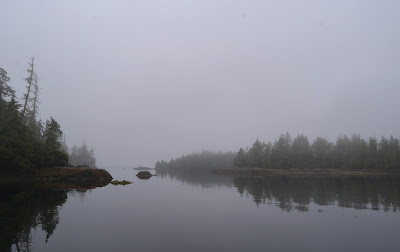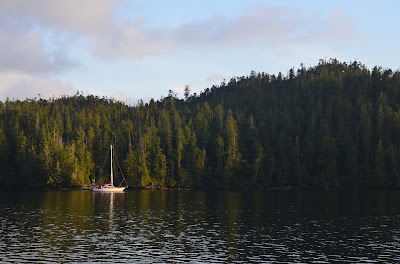The other thing I noticed is how close together all these little islands, islets, and reefs actually are. Barkley Sound is only 13 miles across, and the Broken Group occupies only half of it, so we generally spent more time getting organized, unanchoring, reanchoring and getting ourselves sorted out than we spent actually getting anywhere.
We didn't have to wait long for the fog to lift, by the time we had settled at anchor the sky was blue and the sun shone again. The bay is home to two of the largest kayak camps in Barkley Sound, so there is a constant flow of kayaks coming and going. Many use the island as a base and do day-trips to the surrounding islands, returning to their camps each night.
At low tide you could see the reef that cuts the bay in half, leaving a small cut in the middle for transit. We went around a few of the local islands in the dinghy, being very careful because the swell from the open ocean penetrates quite far into the sound. The islands reminded us a lot of the Gulf Islands, mostly low and small, but there was a lot more wildness to these ones.
"Red sky at night, sailor delight, red sky at morn, sailor be warned". I don't shoot a lot of sunrises, I'm lazy for starters and the sunrises on the west coast are generally shrouded in fog. However, this one was definitely red, so we paid attention. We had stayed in that corner of the bay for a couple of days, enjoying the good weather, but the weather forecast was turning sour, and there was a major blow predicted for the coast, winds southeast to 45 knots in our area, 55 knots further north. We thought that the other side of the bay would be more protected and the predicted wind put us on a lee shore where we were currently, so we upped anchor on the 25th and moved to the southeast corner, where we would be protected by the tall trees.
For a while, it seemed that everything was working according to plan. The rain overnight was plentiful and hard, and the wind whistled through the rigging. As the wind built, however, it started curling around the southeast corner in vigorous blasts, driving us further back on the anchor and swinging us closer to shore.
I was maintaining anchor watch using our GPS, and when the swing suddenly moved back substantially, I decided that I didn't want to risk dragging onto the pile of rocks that was looming closer, so we moved to the middle of the bay and reanchored.
I was trying to lash the kayak down on the foredeck when the wind suddenly caught it and it was held in the air horizontally beside the boat, with me hanging on grimly. I finally managed to get it down into the water and it rode happily next to the dinghy behind the boat, both getting ever fuller with rainwater. It was much windier out there but I could put out a lot more anchor line and felt much more secure knowing I could drag for hundreds of feet without hitting anything. As it turned out, this anchor set did not move an inch and we rode the storm out without further mishap. We felt much luckier than the kayakers; one little boy riding in the front seat of a double, with his oilskin-clad father paddling, said "Wouldn't you like a boat that size, Dad?" Dad, tired, dirty, bearded and dripping wet, gazed wistfully up at our boat, and answered "that sure would be nice". It sure was.
We had spent more time in Joe's Bay than we had intended due to getting storm-ready, the holding tank was full and we had to get out to deep water to pump it out, and we were getting tired of looking at the same landscape, so on Tuesday Aug. 27 we took advantage of a relatively rain-free break and set out for Jaques-Jarvis Lagoon. Although it was only three miles away we managed to double that by exploring some of the surrounding islands on the way. Jaques-Jarvis Lagoon is noted for its difficult entrance, so of course we had to go there. The guide books stated we should go in an hour before high tide with the sun behind us. We were there three hours before high tide with fog and a ripple on the water. With a charted depth of three feet at low tide, squeezed in by a reef from one side and a rock on the other, the entry was taken very slowly and carefully, with a bow lookout. We managed a good line in with a minimum depth of 10 feet under our 6'6" draft keel and a couple of feet to spare on each side.
One of the writers commenting on the lagoon uses the word "primeval", and it certainly was. There was total silence but for the gurgle of a waterfall hidden in the trees, the water was glassy calm, and the foliage in the overcast light looked incredibly green, like someone had doubled the saturation. We took advantage of the momentary lack of rain to do a dinghy survey of our watery kingdom, since of course we were alone again. It was one of those places where you couldn't imagine putting a noisy engine on the dinghy; it was almost sacreligious to make noise from water dripping from the oars.
It had been a week since we left Ucluelet. We had emptied our reserve 5 gallons of water into the tanks, we had a couple of slices of bread and a couple of cups of milk left, so our time in the lagoon was unfortunately limited. Our night there was punctuated by bursts of heavy rain, but thankfully no strong wind could penetrate. The forecast was for more rain and wind, so a dry period on Wednesday morning gave us enough of a window to get organized to move. Getting out of the lagoon was made even trickier than the entry because we were nowhere near high tide. With less than seven feet of water, we followed our incoming line exactly and had no problems, but we were moving as slowly as I could manage. The underwater rocks were clearly visible on my side, just feet away. We made a resolution to come back here, we need to see this place again, preferably in sunlight.
Our run back to Ucluelet yesterday was very wet and foggy, but we had phoned ahead (cell phone coverage at last!) and Kevin and his staff were waiting on the dock for us. We got exactly the same space we had left a week earlier, so we tied up and set about drying out. We had foulie jackets and pants hanging all over the boat, we had damp charts taped up in the salon, and we had a lot of just plain wet everywhere. Lunch at the Floathouse Restaurant was a wonderful thing, as were the hot showers later. We went shopping at the Co-op and marveled at all the things on the shelves, but we were focused. Anne came up with a great idea: we took Ziploc freezer bags with us, bought our meats for the next week, divided them up and put them in the freezer bags on the spot, and handed them over to the butcher, who was happy to freeze them for us overnight.
It's Thursday, it's howling wind and pouring rain out there, and we are staying another night on the dock in good ol' Ucluelet. We picked up our frozen meats and a bunch of other supplies but tonight we're going to get all dressed up and go out for dinner. Unfortunately, dressing up in foul-weather gear and staggering down the slick dock to the Floathouse is going to be as good as it gets.
 | |
| We won't be dining outside this time...stylin' in Ukee |

















































